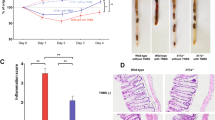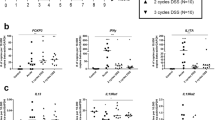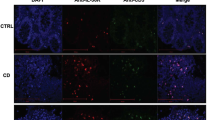Abstract
Recent studies that have evaluated the immunologic factors that mediate the development of the two forms of inflammatory bowel disease, namely Crohn's disease and ulcerative colitis (UC), have suggested that these diseases are because of disparate immune responses. Although Crohn's disease has been characterized as a dysregulation of the T helper (Th)1/Th17 pathways more recent evidence has emerged that UC pathogenesis is associated with a nonclassical NK (natural killer) T cell producing an atypical Th2 (interleukin (IL)-13) response. In the following review the insights gained from both animal models and human studies as to the function that IL-13 and NK T cells have in the pathogenesis of UC will be discussed.
Similar content being viewed by others
Introduction
In contrast to Crohn's disease, the immunopathogenesis of ulcerative colitis (UC) has been a more difficult disease to ascertain. This, owing to the fact that it did not fit neatly into a niche of the T helper (Th)1/Th2 paradigm. In particular, it was evident that cells from this disease produced neither excessive interferon-γ (Th1), nor interleukin (IL)-4, the major Th2 cytokine.1 Indeed, IL-4 production was found to be decreased in cells extracted from UC tissue and only the increased presence of an additional Th2 cytokine IL-5, gave reason that the disease may be Th2 mediated.
Oxazolone Colitis
To understand better the immune responses that may have a function in the pathogenesis of human UC, initial investigations turned to the analysis of murine models of intestinal inflammation. One such model is that of the hapten-induced oxazolone colitis. In initial studies, it was found that administration of oxazolone led to a short-lived colitis (lasting less than 5 days in duration) which had features of human UC—in particular superficial inflammation of the gut wall associated with edema, ulceration of the epithelial cell layer, and neutrophil accumulation.2 This pathological picture differed greatly from the other type of hapten-induced colitis (trinitrobenzene sulfonic acid colitis), which was characterized by a densely packed transmural lesion.
A second difference between trinitrobenzene sulfonic acid colitis and oxazolone colitis also emerged from the studies of the cytokine secretion patterns in these inflammations. These studies revealed that CD4+ T cells present in oxazolone-colitis lesions produce initially a large amounts of Th2 type cytokines (IL-4 and IL-5)2 in contrast to the increased amount of Th1 cytokines (interferon-γ) found in trinitrobenzene sulfonic acid colitis. Furthermore, it was evident that this Th2 cytokine response had an initial function in the immune pathogenesis of oxazolone colitis since administration of anti-IL-4 to mice at the time of disease induction prevented the development of colitis. However, as this form of oxazolone colitis was short-lived in nature, further studies investigating a more prolonged form of oxazolone colitis, lasting 1–2 weeks was examined.3 This was accomplished using a pre-sensitization regimen in which the abdomen was precoated with oxazolone 1 week before the administration of a low dose intra-rectal oxazolone challenge. This more chronic model demonstrated that the initial IL-4 response was superseded after approximately 4–5 days with an increasing IL-13 response. This latter response was intrinsic to disease pathogenesis as the colitis could be prevented by administration of IL-13R2α-Fc, a soluble receptor for IL-13 that blocks IL-13 interaction with its signaling receptor.
The next question to be addressed was the cellular origin of the cytokine response, particularly IL-13 production and its targets. Interestingly, this turned out to be a natural killer T cell (NK T cell), i.e., a CD4+ T cell bearing NK markers that take part in innate immune responses through their capacity to function as cytotoxic cells that can produce either Th1 (interferon-γ) or Th2 (IL-4/IL-13) cytokines under various circumstances. To understand the significance of how NK T cells may be intrinsic to the inflammation of oxazolone colitis, we need to discuss the nature and function of these cells. An NK T cell has characteristics of both an NK cell and a cell with T-cell receptors that nevertheless bears surface NK markers (such as NK1.1). In addition to its distinctive surface markers, the NK T cell can be defined by the fact that it recognizes glycolipid antigens presented to it by a highly conserved MHC class I-like molecule, (CD1 in mice and CD1d in humans) and in most cases it expresses an invariant T-cell receptor that is made up of a particular T-cell receptorα chain (Vα14-Jα281 in mice and Vα24-Jα18 in humans) linked to a restricted repertoire of Vβ chains, hence the fact that it can be stimulated by a particular prototype glycolipid, α-galactosyl-ceramide.4 However, it is important to recognize that although the great majority of NK T cells have these attributes, a minority of NK T cells (“non-classical” NK T cells), while still recognizing antigen restricted by CD1, bear non-invariant T-cell receptors.5 An additional characteristic of NK T cells is their ability to act as cytotoxic T cells and it is this property that accounts for the fact that NK T cells have anti-tumor cell activity and act as effector cells in certain inflammatory states such as experimental hepatitis.6 In the latter regard, it has been shown that NK T cells in hepatic lesions secrete perforin and granzymes that mediate cellular injury.7 Finally, it is important to emphasize that NK T can be activated by CD1-bearing antigen presenting cells in the absence of added antigen.8 This latter point indicates that NK T cells probably recognize self-antigens present in the groove of CD1 derived antigen-presenting cells; in other words, NK T cells can be self-antigen specific. Thus, NK T cells are important components of the innate immune system, as they do not require exogenous antigens to begin secreting cytokines.
Evidence for the identification of the NK T cell as the source of IL-13 in oxazolone colitis drew on these NK T-cell characteristics and included the fact that administration of anti-NK T-cell antibodies to mice prevented development of oxazolone colitis. In addition, the latter could not be induced in mice deficient in CD1.3 Finally and perhaps most importantly, stimulation of lamina propria T cells extracted from oxazolone-colitis tissue with antigen-presenting cells bearing CD1 resulted in IL-13 secretion. Therefore, these studies of a murine model of UC strongly suggested that the pathogenesis of the colitis was because of the generation of NK T cells that secrete IL-13. From these data it was inferred that oxazolone colitis could be because of a direct effect of IL-13 on epithelial cells or an effect (cytolytic) of NK T cells on epithelial cells.
Taken together, this information concerning NK T cells, it is possible to construct a mechanism of how these cells mediate oxazolone colitis (see Figure 1). First, oxazolone may act as a unique kind of haptenating agent that has the particular ability to induce NK T-cell development, presumably by giving rise to a lipid moiety that is presented to a small but expandable population of NK T cells in the context of CD1 on antigen-presenting cells. In the intestinal tract, the latter would include not only antigen-presenting cells, but also gut epithelial cells, which have been shown to express CD1.9 Second, these NK T cells then proliferate and differentiate into Th2 type cells. Initially, they begin to produce IL-4 and IL-13, the latter a cytokine, which may act as an autocrine factor that causes the NK T cells to become cytotoxic effector cells with the capacity to cause tissue injury. The immediate target of possible NK T-cell activity in oxazolone colitis may in fact be the epithelial cell since, as mentioned, this cell bears CD1 and can present antigens to NK T cells. Such cytotoxicity could be responsible for the ulceration of the mucosa and observed alteration of the epithelial barrier. Third, once this occurs, there is the possibility of penetration of the mucosa by bacteria in the mucosal microflora and thus further NK T-cell stimulation by antigens in the flora that are cross-reactive with self antigens. However, these latter points concerning changes in epithelial barrier function may be brought about not only by NK T cells but also by IL-13 itself.
Proposed mechanism for experimental and human ulcerative colitis. Innate antigen is presented to and taken up by lamina propria antigen-presenting cells bearing CD1, which in turn presents to NK T cells. These NK T cells are then activated to secrete IL-13. IL-13 may bring about changes in epithelial barrier function leading to further antigen exposure. In addition, NK T cells upon activation may be directly cytotoxic to epithelial cells. NK T cell, natural killer; IL, interleukin.
In further studies, investigating the function of IL-13 and epithelial barrier function, Heller et al.10 demonstrated that IL-13 can have a direct effect on epithelial barrier function in a multitude of ways. Concerning effects on epithelial cells, when IL-13 was added in vitro, a dose-dependent decrease in electrical resistance of HT-29 epithelial cell monolayers was observed. Concomitantly, an increase in cellular epithelial apoptotic rate was also found. These changes in epithelial cell function could give rise to a change in barrier function.
Furthermore, the addition of IL-13 in vitro to these monolayer cultures led to an increased expression of the pore-forming tight junction protein claudin-2. This protein when found at increased levels is associated with increased epithelial barrier permeability. More significantly, examination of the lamina propria tissue from human UC patients also demonstrated similar changes in claudin-2 expression. These results suggest that the changes in barrier function in human UC may not only be because of cytolytic destruction of the epithelial layer by NK T cells but concomitantly because of a more subtle alteration secondary to effects from IL-13. Thus, this cytokine may have a dual pathogenic role—first, directly affecting epithelial cells and the second, as a stimulant of NK T-cell cytotoxicity.
Ulcerative Colitis
Given the above findings, the next series of studies focused on the human disease counterpart, UC, to ascertain if similar mechanisms had a significant function. Here it was found that lamina propria cells isolated from inflamed UC tissue stimulated in vitro did indeed produce increased amounts of IL-13 as compared with cells from both control individuals and patients with Crohn's disease.11 Moreover, depletion of cells bearing a marker found on NK T cells (CD161) from the lamina propria cell population extracted from UC tissue, followed by stimulation in vitro led to greatly decreased IL-13 production.
Further studies investigating the link between NK T cells and IL-13 production in UC came from flow cytometric analysis that revealed that whereas both UC and CD lamina propria mono-nuclear cells contained increased numbers of cells bearing a surface marker found on NK T cells (CD161), those from UC specimens were producing IL-13, whereas those from Crohn's disease specimens were producing IFN-γ.11 Perhaps more importantly, it was observed that antigen-presenting cells bearing a CD1d construct (and thus expressing CD1d on its surface) could only induce lamina propria mononuclear cells from UC patients but not that of Crohn's disease to produce any cytokine (in particular, IL-13). Thereby, establishing that, in fact, the cytokine secretion profile seen in UC was produced from a non-classical CD1 dependent NK T cell whereas the cytokines produced in Crohn's disease were from that of an activated classical Th1 CD4+ T cell.
One final important finding in the study of UC patients only hinted in the animal studies, was that lamina propria cells enriched for NK T cells from the patients could be shown to be cytotoxic for epithelial cells and such cytotoxicity was further enhanced by IL-13,11 suggesting an associated link between IL-13 and NK T cells in the pathogenic mechanisms of this inflammation. On this basis, an additional possibility for the immunopathologic mechanism operating in UC is that antigens in the mucosal microflora activate NK T cells because of aforementioned changes in barrier function that, in turn, cause cytolysis of epithelial cells and the characteristic ulcerations associated with the disease. However, additional factors other than that of the mucosal flora may activate NK T cells. As suggested, enhancement of cytolytic activity was observed in vitro in the presence of IL-13. IL-13, therefore, may have an autocrine function in the activation of these cells. How IL-13 may function in this capacity may be inferred from a recent study.12 IL-13 was shown to have direct effects on activation of cytokine transcription. These studies demonstrated that TGF-β transcription was dependent upon IL-13 acting through a receptor previously thought to function as a decoy (IL-13Rα2). Whether IL-13 can indeed induce transcription of other cytokines (namely itself) or activation of NK T cells through a similar manner remains to be determined.
In summary, these considerations bring us back to the opening comments of this discussion. The point to make is that we have made many inroads to the understanding of inflammatory bowel disease in all its complexity. The information obtained point towards new avenues of treatment. However, the final proof that IL-13 and NK T cells have a significant function in human UC awaits study in a human trial in which these components may be blocked or depleted.
Disclosure
Ivan J. Fuss is a patent holder for the use of anti-IL-12 mAb in the treatment of Crohn's disease.
References
Fuss, I.J. et al. Disparate CD4+ lamina propria (LP) lymphokines secretion profiles in inflammatory bowel disease. Crohn's disease LP cells manifest increased secretion of IFN-γ, whereas ulcerative colitis LP cells manifest increased secretion of IL-5. J. Immunol. 153, 1261–1270 (1996).
Boirivant, M., Fuss, I.J., Chu, A. & Strober, W. Oxazalone colitis: a murine model of T helper cell type 2 colitis treatable with antibodies to inteleukin 4. J. Exp. Med. 188, 1929–1939 (1998).
Heller, F., Fuss, I.J., Niewenhuis, E.E., Blumberg, R.S. & Strober, W. Oxazalone colitis, a Th2 colitis model resembling ulcerative colitis, is mediated by IL-13-producing NK-T cells. Immunity 17, 629–638 (2002).
Kronenberg, M. & Gapin, L. The unconventional lifestyle of NKT cells. Nat. Rev. Immunol. 2, 557–568 (2002).
Brigl, M. & Brenner, M.B. CD1: antigen presentation and T cell function. Annu. Rev. Immunol. 22, 817–890 (2004).
Baron, J.L., Gardiner, L., Nishimura, S. & Shinkai, K. Activation of a nonclassic NKT cell subset in a transgenic mouse model of hepatitis B virus infection. Immunity 16, 583–594 (2002).
Dao, T., Mehal, W.Z. & Crispe, I.N. IL-18 augments perforin-dependent cytotoxicity of liver NK-T cells. J. Immunol. 161, 2217–2222 (1998).
Brutkiewicz, R.R., Bennink, J.R., Yewdell, J.W. & Bendelac, A. TAP-independent beta 2-microglobulin-dependent surface expression of functional mouse CD1.1. J. Exp. Med. 182, 1913–1919 (1995).
van de Wal, Y. et al. Delineation of a CD1d-restricted antigen presentation pathway associated with human and mouse intestinal epithelial cells. Gastroenterology 124, 1420–1431 (2003).
Heller, F. et al. Interleukin-13 is the key effector Th2 cytokine in ulcerative colitis that affects epithelial tight junctions, apoptosis, and cell restitution. Gastroenterology 129, 550–564 (2005).
Fuss, I.J. et al. Nonclassical CD1d-restricted NK T cells that produce IL-13 characterize an atypical Th2 response in ulcerative colitis. J. Clin. Invest. 113, 1490–1497 (2004).
Fichtner-Feigl, S., Strober, W., Kawakami, K., Puri, R.K. & Kitani, A. IL-13 signaling through the IL-13α2 receptor is involved in induction of TGF-β1 production and fibrosis. Nat. Med. 12, 99–106 (2006).
Author information
Authors and Affiliations
Corresponding author
PowerPoint slides
Rights and permissions
About this article
Cite this article
Fuss, I., Strober, W. The role of IL-13 and NK T cells in experimental and human ulcerative colitis. Mucosal Immunol 1 (Suppl 1), S31–S33 (2008). https://doi.org/10.1038/mi.2008.40
Published:
Issue Date:
DOI: https://doi.org/10.1038/mi.2008.40
This article is cited by
-
Therapeutic effect of the sulforaphane derivative JY4 on ulcerative colitis through the NF-κB-p65 pathway
Inflammopharmacology (2022)
-
Intestinal vitamin D receptor knockout protects from oxazolone-induced colitis
Cell Death & Disease (2020)
-
Design and validation of a disease network of inflammatory processes in the NSG-UC mouse model
Journal of Translational Medicine (2017)
-
Intestinally-restricted Janus Kinase inhibition: a potential approach to maximize the therapeutic index in inflammatory bowel disease therapy
Journal of Inflammation (2017)
-
Therapeutic Targets in Inflammatory Bowel Disease: Current and Future
The American Journal of Gastroenterology Supplements (2016)




